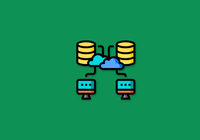In high-performance computing scenarios, all-flash architectures and kernel-mode parallel file systems are often used to meet performance requirements. However, as data volumes and distributed system clusters grow, the high cost of all-flash storage and the operational complexity of kernel clients become major challenges.
JuiceFS is a cloud-native distributed file system operating entirely in user space. It significantly boosts I/O throughput through distributed caching and uses cost-effective object storage for data storage. This makes it suitable for large-scale AI workloads.
The data reading process in JuiceFS starts with a read request from the client, which is sent to the JuiceFS client via FUSE. This request then passes through a readahead buffer layer, enters the cache layer, and ultimately accesses object storage. To enhance reading efficiency, JuiceFS employs various strategies in its architecture, including data readahead, prefetch, and cache.
In this article, we’ll analyze the working principles of these strategies in detail and share our test results in specific scenarios. Our article will help you deeply understand the performance advantages and limitations of JuiceFS. You can more effectively apply JuiceFS to various usage scenarios.
To read this article, a basic knowledge of operating systems is required. You can bookmark this article for careful reading when needed.
Introduction to JuiceFS architecture
The architecture of JuiceFS Community Edition has three main components: the client, data storage, and metadata. Data access is supported through various interfaces, including POSIX, HDFS API, S3 API, and Kubernetes CSI, catering to different application scenarios. In terms of data storage, JuiceFS supports dozens of object storage solutions, including public cloud services and self-hosted solutions such as Ceph and MinIO. The metadata engine is compatible with several common databases, including Redis, TiKV, and PostgreSQL.
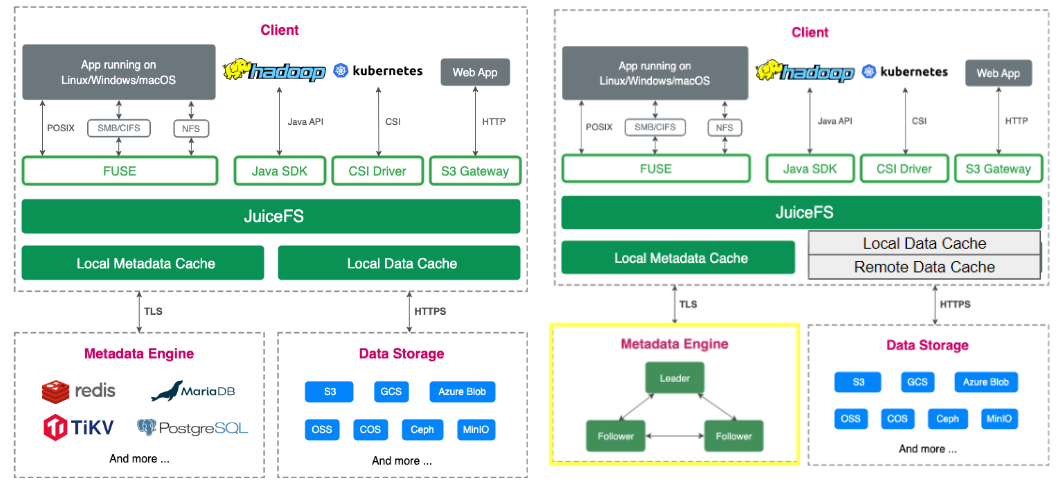
The primary differences between the community edition and the enterprise edition are in handling the metadata engine and data caching, as shown in the figure above. The enterprise edition includes a proprietary distributed metadata engine and supports distributed cache, whereas the community edition only supports local cache.
Concepts of reads in Linux
In the Linux system, data reading is implemented through several methods:
- Buffered I/O: This is the standard file reading method. Data passes through the kernel buffer. The kernel performs readahead operations to optimize reading efficiency.
- Direct I/O: This method allows file I/O operations to bypass the kernel buffer. This reduces data copying and memory usage. It’s suitable for large data transfers.
- Asynchronous I/O: Often used with direct I/O, it allows applications to issue multiple I/O requests within a single thread without waiting for each request to complete. This improves I/O concurrency performance.
- Memory map: This method maps files into the process' address space, allowing direct access to file content through pointers. With memory mapping, applications can access the mapped file area as if it were regular memory, with the kernel automatically handling data reads and writes.
These reading modes bring specific challenges to storage systems:
- Random reads: Including both random large I/O reads and random small I/O reads, these primarily test the storage system's latency and IOPS.
- Sequential reads: These primarily test the storage system's bandwidth.
- Reading a large number of small files: This tests the performance of the storage system's metadata engine and the overall system's IOPS capabilities.
JuiceFS read process analysis
JuiceFS employs a strategy of file chunking. A file is logically divided into several chunks, each with a fixed size of 64 MB. Each chunk is further subdivided into 4 MB blocks, which are the actual storage units in the object storage. Many performance optimization measures in JuiceFS are closely related to this chunking strategy. Learn more about the JuiceFS storage workflow.
To optimize read performance, JuiceFS implements several techniques such as readahead, prefetch, and cache.
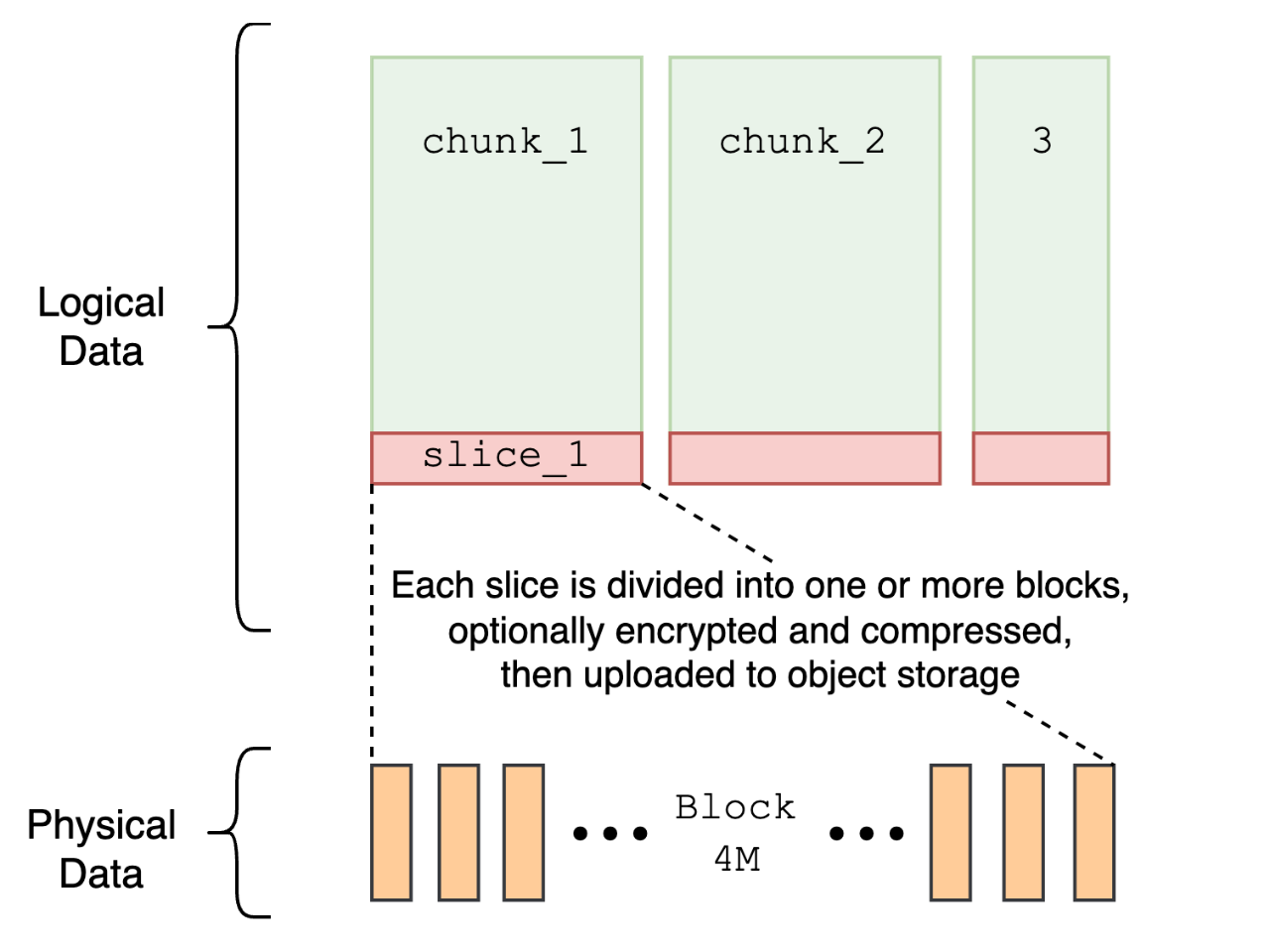
Readahead
Readahead is a technique that anticipates future read requests and preloads data from the object storage into memory. It reduces access latency and improves actual I/O concurrency. The figure below shows the read process in a simplified way. The area below the dashed line represents the application layer, while the area above it represents the kernel layer.
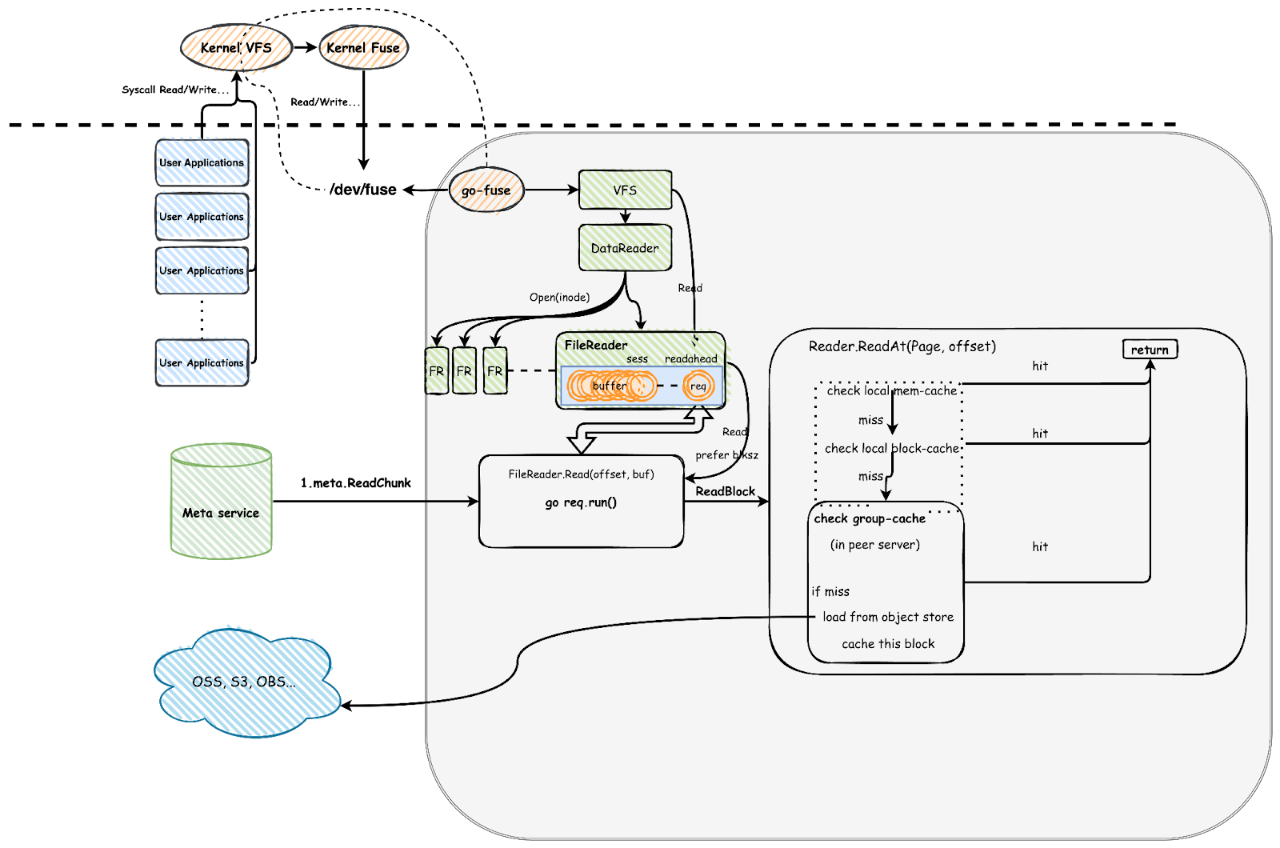
When a user process (the application layer marked in blue in the lower left corner) initiates a system call for file reading and writing, the request first passes through the kernel's virtual file system (VFS), then to the kernel's FUSE module. It communicates with the JuiceFS client process via the /dev/fuse device.
The process illustrated in the lower right corner demonstrates the subsequent readahead optimization within JuiceFS. The system introduces sessions to track a series of sequential reads. Each session records the last read offset, the length of sequential reads, and the current readahead window size. This information helps determine if a new read request hits this session and automatically adjusts or moves the readahead window. By maintaining multiple sessions, JuiceFS can efficiently support high-performance concurrent sequential reads.
To enhance the performance of sequential reads, we introduced measures to increase concurrency in the system design. Each block (4 MB) in the readahead window initiates a goroutine to read data. It’s important to note that concurrency is limited by the buffer-size parameter. With a default setting of 300 MB, the theoretical maximum concurrency for object storage is 75 (300 MB divided by 4 MB). This setting may not suffice for some high-performance scenarios, and users need to adjust this parameter according to their resource configuration and specific requirements. We have tested different parameter settings in subsequent content.
For example, as shown in the second row of the figure below, when the system receives a second sequential read request, it actually initiates a request that includes the readahead window and three consecutive data blocks. According to the readahead settings, the next two requests will directly hit the readahead buffer and be returned immediately.
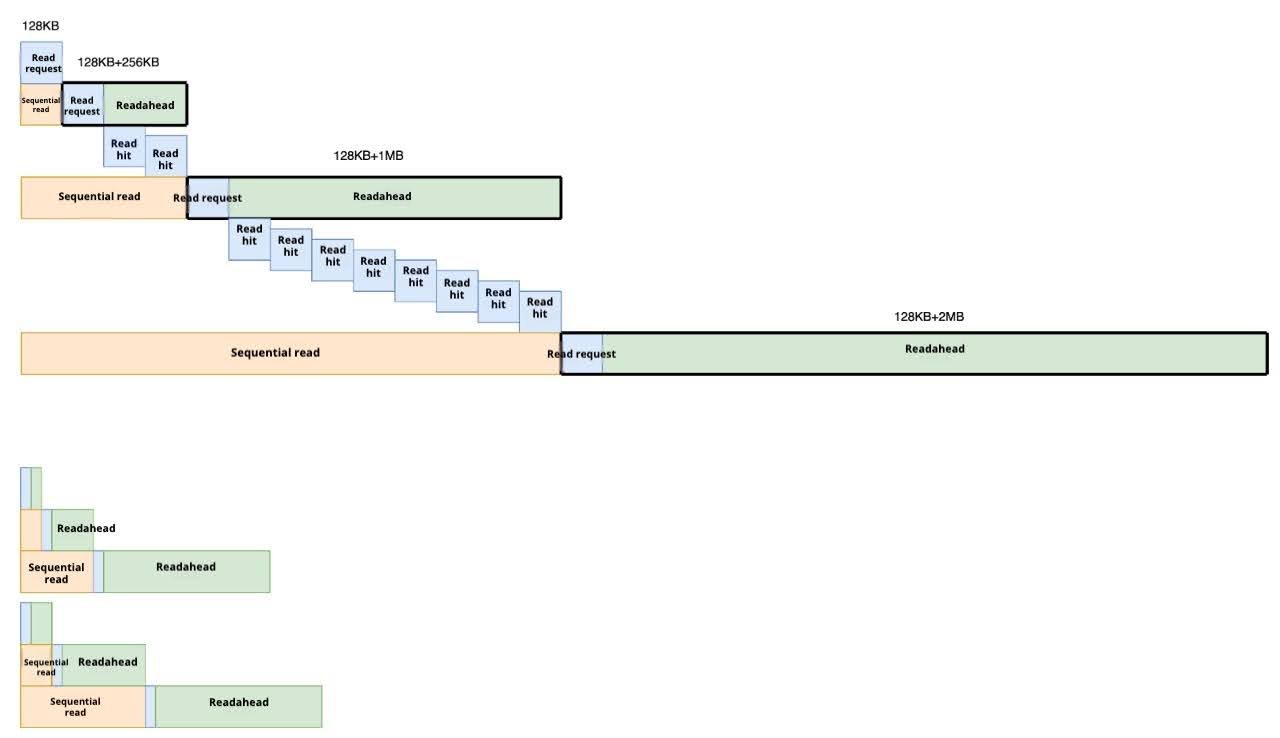
If the first and second requests do not use readahead and directly access object storage, the latency will be high (usually greater than 10 ms). When the latency drops to within 100 microseconds, it indicates that the I/O request successfully used readahead. This means the third and fourth requests directly hit the data preloaded into memory.
Prefetch
Prefetching occurs when a small segment of data is read randomly from a file. We assume that the nearby region might also be read soon. Therefore, the client asynchronously downloads the entire block containing that small data segment.
However, in some scenarios, prefetching might be unsuitable. For example, if the application performs large, sparse, random reads on a large file, prefetching might access unnecessary data, causing read amplification. Therefore, if users already understand their application's read patterns and determine that prefetching is unnecessary, they can disable it using --prefetch=0.
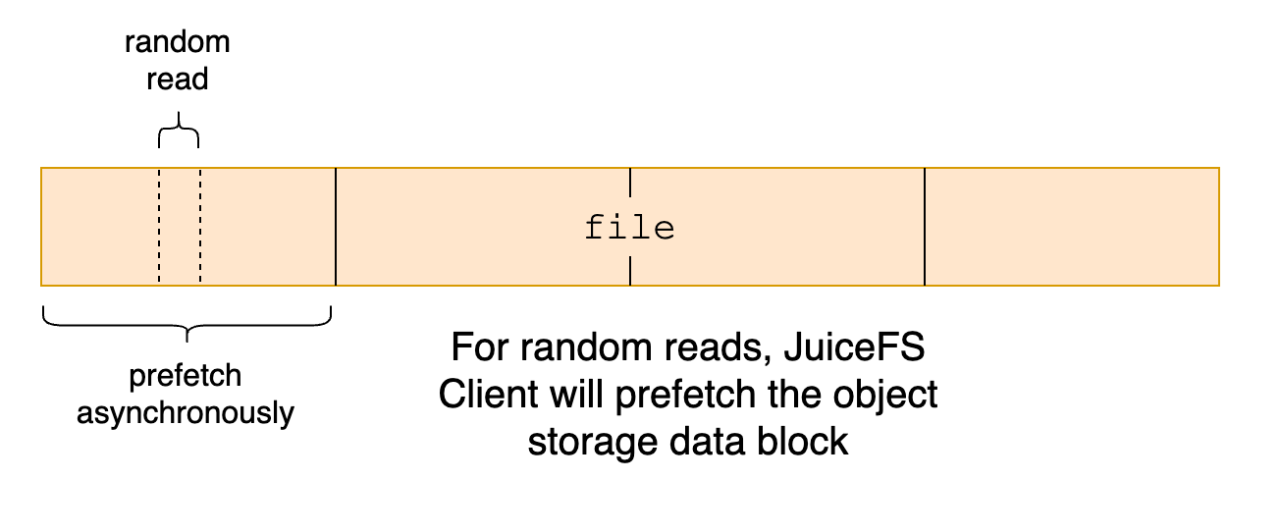
Cache
You can learn about the JuiceFS cache in this document. This article will focus on the basic concepts of cache.
Page cache
The page cache is a mechanism provided by the Linux kernel. One of its core functionalities is readahead. It preloads data into the cache to ensure quick response times when the data is actually requested.
The page cache is particularly crucial in certain scenarios, such as when handling random read operations. If users strategically use the page cache to pre-fill file data, such as reading an entire file into the cache when memory is free, subsequent random read performance can be significantly improved. This can enhance overall application performance.
Local cache
JuiceFS local cache can store blocks in local memory or on local disks. This enables local hits when applications access this data, reduces network latency, and improves performance. High-performance SSDs are typically recommended for local cache. The default unit of data cache is a block, 4 MB in size. It’s asynchronously written to the local cache after it’s initially read from object storage.
For configuration details on the local cache, such as --cache-dir and --cache-size, enterprise users can refer to the Data cache document.
Distributed cache
Distributed cache is a significant feature of JuiceFS Enterprise Edition. Unlike local cache, the distributed cache aggregates the local caches of multiple nodes into a single cache pool, thereby increasing the cache hit rate. However, distributed cache introduces an additional network request. This results in slightly higher latency compared to local cache. The typical random read latency for distributed cache is 1-2 ms; for local cache, it’s 0.2-0.5 ms. For the details of the distributed cache architecture, see Distributed cache.
FUSE and object storage performance
JuiceFS' read requests all go through FUSE, and the data must be read from object storage. Therefore, understanding the performance of FUSE and object storage is the basis for understanding the performance of JuiceFS.
FUSE performance
We conducted two sets of tests on FUSE performance. The test scenario was that after the I/O request reached the FUSE mount process, the data was filled directly into the memory and returned immediately. The test mainly evaluated the total bandwidth of FUSE under different numbers of threads, the average bandwidth of a single thread, and the CPU usage. In terms of hardware, test 1 is Intel Xeon architecture, and test 2 is AMD EPYC architecture.
The table below shows the test results of FUSE performance test 1, based on Intel Xeon CPU architecture:
| Threads | Bandwidth (GiB/s) | Bandwidth per thread (GiB/s) | CPU usage (cores) |
|---|---|---|---|
| 1 | 7.95 | 7.95 | 0.9 |
| 2 | 15.4 | 7.7 | 1.8 |
| 3 | 20.9 | 6.9 | 2.7 |
| 4 | 27.6 | 6.9 | 3.6 |
| 6 | 43 | 7.2 | 5.3 |
| 8 | 55 | 6.9 | 7.1 |
| 10 | 69.6 | 6.96 | 8.6 |
| 15 | 90 | 6 | 13.6 |
| 20 | 104 | 5.2 | 18 |
| 25 | 102 | 4.08 | 22.6 |
| 30 | 98.5 | 3.28 | 27.4 |
The table shows that:
- In the single-threaded test, the maximum bandwidth reached 7.95 GiB/s while using less than one core of CPU.
- As the number of threads grew, the bandwidth increased almost linearly. When the number of threads grew to 20, the total bandwidth increased to 104 GiB/s.
Here, users need to pay special attention to the fact that the FUSE bandwidth performance measured using different hardware types and different operating systems under the same CPU architecture may be different. We tested using multiple hardware types, and the maximum single-thread bandwidth measured on one was only 3.9 GiB/s. The table below shows the test results of FUSE performance test 2, based on AMD EPYC CPU architecture:
| Threads | Bandwidth (GiB/s) | Bandwidth per thread (GiB/s) | CPU usage (cores) |
|---|---|---|---|
| 1 | 3.5 | 3.5 | 1 |
| 2 | 6.3 | 3.15 | 1.9 |
| 3 | 9.5 | 3.16 | 2.8 |
| 4 | 9.7 | 2.43 | 3.8 |
| 6 | 14.0 | 2.33 | 5.7 |
| 8 | 17.0 | 2.13 | 7.6 |
| 10 | 18.6 | 1.9 | 9.4 |
| 15 | 21 | 1.4 | 13.7 |
In test 2, the bandwidth did not scale linearly. Especially when the number of concurrencies reached 10, the bandwidth per concurrency was less than 2 GiB/s.
Under multi-concurrency conditions, the peak bandwidth of test 2 (EPYC architecture) was about 20 GiBps, while test 1 (Intel Xeon architecture) showed higher performance. The peak value usually occurred after the CPU resources were fully occupied. At this time, both the application process and FUSE process reached CPU resource limit.
In actual applications, due to the time overhead in each stage, the actual I/O performance is often lower than the above-mentioned test peak of 3.5 GiB/s. For example, in the model loading scenario, when loading model files in pickle format, usually the single-thread bandwidth can only reach 1.5 to 1.8 GiB/s. This is mainly because when reading the pickle file, data deserialization is required, and there will be the bottleneck of CPU single-core processing. Even when reading directly from memory without going through FUSE, the bandwidth can only reach up to 2.8 GiB/s.
Object storage performance
We used the juicefs objbench tool for testing object storage performance, covering different loads of single concurrency, 10 concurrency, 200 concurrency, and 800 concurrency. It should be noted that the performance gap between different object stores may be large.
| Load | Upload objects (MiB/s) | Download objects (MiB/s) | Average upload time (ms/object) | Average download time (ms/object) |
|---|---|---|---|---|
| Single concurrency | 32.89 | 40.46 | 121.63 | 98.85 |
| 10 concurrency | 332.75 | 364.82 | 10.02 | 10.96 |
| 200 concurrency | 5,590.26 | 3,551.65 | 067 | 1.13 |
| 800 concurrency | 8,270.28 | 4,038.41 | 0.48 | 0.99 |
When we increased the concurrency of GET operations on object storage to 200 and 800, we could achieve very high bandwidth. This indicates that the bandwidth for single concurrency is very limited when reading data directly from object storage. Increasing concurrency is crucial for overall bandwidth performance.
Sequential read and random read tests
To provide a clear benchmark reference, we used the fio tool to test the performance of JuiceFS Enterprise Edition in sequential and random read scenarios.
Sequential read
As shown in the figure below, 99% of the data had a latency of less than 200 microseconds. In sequential read scenarios, the readahead window performed very well, resulting in low latency.
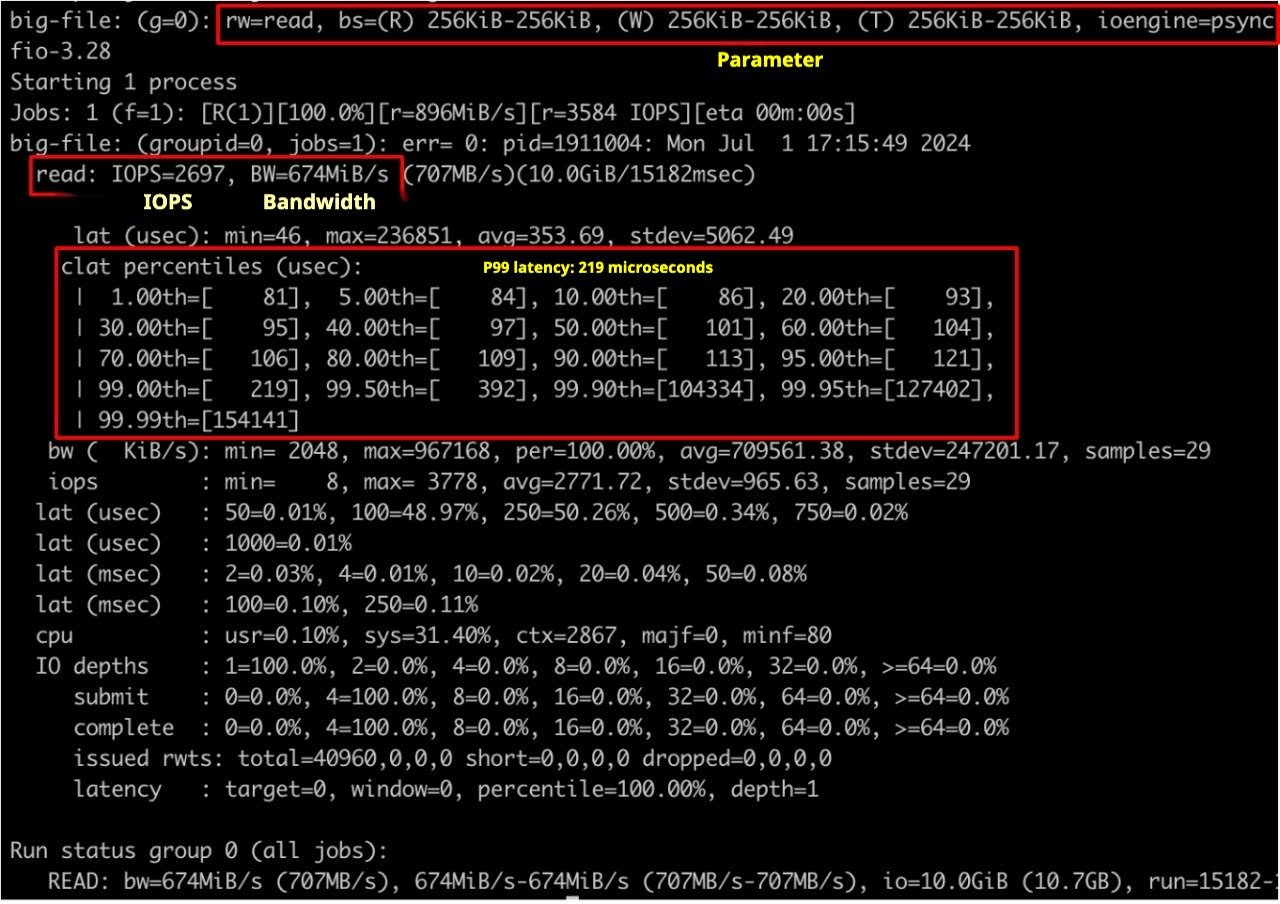
By default, buffer-size=300MiB, sequential reading of 10 GB from object storage.
By increasing the readahead window, we improved I/O concurrency and thus increased bandwidth. When we adjusted buffer-size from the default 300 MiB to 2 GiB, the read concurrency was no longer limited, and the read bandwidth increased from 674 MiB/s to 1,418 MiB/s. It reached the performance peak of single-threaded FUSE. To further increase bandwidth, it’s necessary to increase the I/O concurrency in the application code.
The table below shows the performance test results of different buffer sizes (single thread):
| buffer-size | Bandwidth |
|---|---|
| 300 MiB | 674 MiB/s |
| 2 GiB | 1,418 MiB/s |
When the number of application threads increased to 4, the bandwidth reached 3,456 MiB/s. For 16 threads, the bandwidth reached 5,457 MiB/s. At this point, the network bandwidth was already saturated.
The table below shows bandwidth performance test results of different thread counts (buffer-size: 2 GiB):
| buffer-size | Bandwidth |
|---|---|
| 1 thread | 1,418 MiB/s |
| 4 threads | 3,456 MiB/s |
| 16 threads | 5,457 MiB/s |
Random read
For small I/O random reads, performance is mainly determined by latency and IOPS. Since total IOPS can be linearly scaled by adding nodes, we first focus on latency data on a single node.
- FUSE data bandwidth refers to the amount of data transmitted through the FUSE layer. It represents the data transfer rate observable and operable by user applications.
- Underlying data bandwidth refers to the bandwidth of the storage system that processes data at the physical layer or operating system level.
As shown in the table below, compared to penetrating object storage, latency was lower when hitting local cache and distributed cache. When optimizing random read latency, it's crucial to consider improving data cache hit rates. In addition, using asynchronous I/O interfaces and increasing thread counts can significantly improve IOPS. The table below shows test results of JuiceFS small I/O random reads:
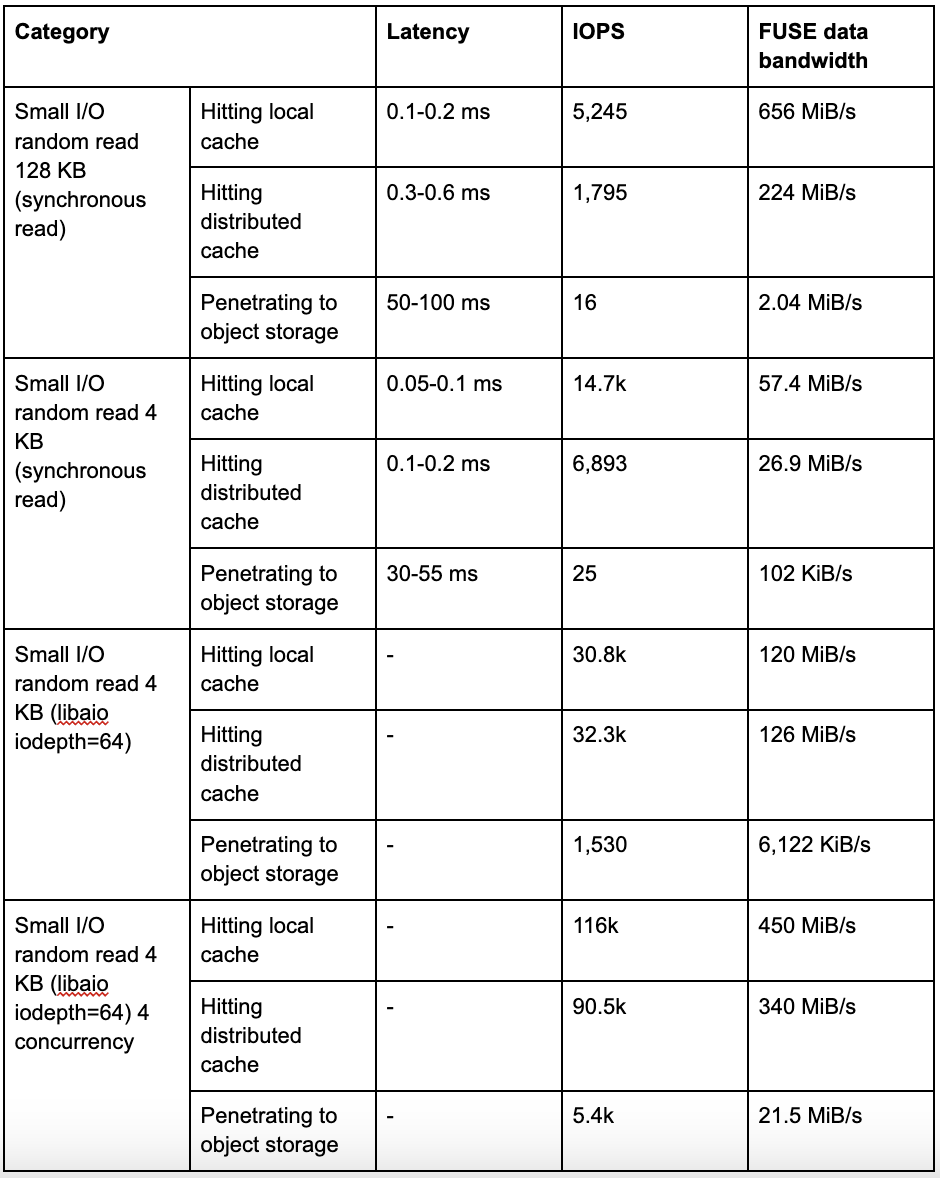
Unlike small I/O scenarios, large I/O random read scenarios must also consider the read amplification issue. As shown in the table below, the underlying data bandwidth was higher than the FUSE data bandwidth due to readahead effects. Actual data requests may be 1-3 times more than application data requests. In this case, you can disable prefetch and adjust the maximum readahead window for tuning.
The table below shows the test results of JuiceFS large I/O random reads, with distributed cache enabled:
| Category | FUSE data bandwidth | Underlying data bandwidth |
|---|---|---|
| 1 MB buffered I/O | 92 MiB | 290 MiB |
| 2 MB buffered I/O | 155 MiB | 435 MiB |
| 4 MB buffered I/O | 181 MiB | 575 MiB |
| 1 MB direct I/O | 306 MiB | 306 MiB |
| 2 MB direct I/O | 199 MiB | 340 MiB |
| 4 MB direct I/O | 245 MiB | 735 MiB |
If you have any questions or issues, you can join JuiceFS discussions on GitHub and our community on Slack.













